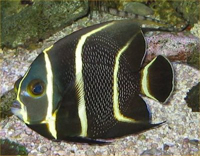Angel Fish

Common Name: Angel Fish
Scientific Name: Pterophyllum Scalare
Description
French Anglefish-Pomacanthus paruAngelfish are, and forever have been, one of the most accepted fish in the diversion today. Many different colored varieties and patterns are accessible, with new ones showing up regularly. They are available in both standard finned and mask varieties, oftentimes beyond 12 inches in height from the top of their dorsal fin to the tilt of their ventral fin. Angels are accessible in a variety to suit just about any aquarist, from normal silvers to golds, to koi varieties to leopard-spotted to black to half-black and just concerning all in between.
Diet
Angelfish can endure on crumble food alone, but they will flourish and be much more appropriate to type on a greatly varied diet. Live foods such as Adult Brine Shrimp, Black Worms, Mosquito larvae, finely chopped earthworms and Guppy fry are established with enthusiasm and should be included often. If live food is not obtainable, frozen packages of Blood Worms (Midge Fly larvae), Brine Shrimp and others are accessible from your favorite pet supply store and are adequate substitutions for the live food. There are many dried foods available that will be adequate too.
Behaviour
Bluering angelfish-Pomacanthus annularisUnlike other fishes, anemonefish can maintain immunity to toxic stinging cells in the anemone's tentacles by constantly stroking their bodies over tentacle surfaces. Some research suggests that the fish secrete mucus that helps protect them from the anemone's sting. Mucus from the anemone builds up on the fish's skin until it becomes 'anemone-like' and the anemone itself does not distinguish between the fish and its own tentacles or recognises the fish as potential food. The anemonefish benefits from the partnership, gaining a protected place to live within the anemone's stinging tentacles.
The anemones also benefit from their partnership with the anemonefish. Anemonefish defend their host anemones from predatory fishes that are immune to the stinging cells. Some researchers also report that anemonefish may 'feed' their anemones by dropping bits of food on the anemone surface. Anemonefish spend their entire adult lives with a single host.
Life History
Life History of Anemone FishAs a general rule anemonefish enter into permanent monogamous pairings. Juveniles live on an anemone with a sexually mature male and female pair. If the female dies, her male partner develops into a female to take her place. The largest juvenile then grows rapidly and replaces him as the dominant male.
Males typically prepare a nest site for spawning and then attract the egg-bearing female to the nest. The male guards the nest from predators and other males while the female lays her eggs in long rows, forming a solid, uniform mass of eggs in a single layer. The eggs adhere to the substrate and clutch size varies from 200 to 2500 eggs depending on the species. Generally the young fish (fry) when hatched are left to look after themselves.
Habitat
These fish live in warm tropical waters, usually at depths of 1-12 m, on sheltered inshore and offshore coral reefs and most importantly, where one or more of 10 favoured host anemone species are found.
Special Features or Habits
Anemonefish can change from male into female. They start off male, but if the female dies the dominant male will change into a female. A non-dominant male will then become the dominant male.
Location or Region Found
Western Pacific: eastern Australia (Great Barrier Reef and Coral Sea, northern New South Wales), New Caledonia, and Loyalty Islands.
 Deep Sea Crabs
Deep Sea Crabs